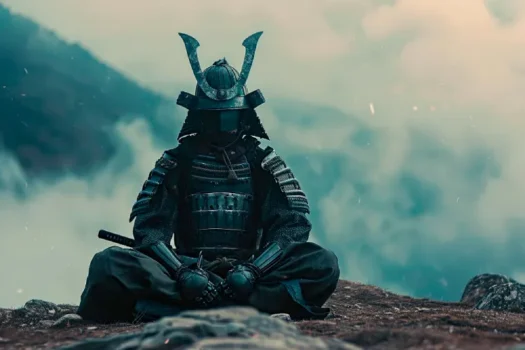Japanese armor (日本の甲冑, Nihon no Katchū) is often seen as both elaborate and strange. Is it made of bamboo? Let’s take a closer look.
When we talk about armor, we’re referring to protective gear worn during the era of cold weapons to shield key body parts like the head and chest. Armor generally falls into three categories: rattan armor (藤甲, Tōkō), leather armor (皮甲, Hikō), and iron armor (鉄甲, Tekkō). Rattan armor is made by weaving together strips of wood, bamboo, or rattan. Leather armor, often made from sharkskin or tough cowhide, is decorated with colorful paintings. Iron armor, as the name suggests, is mostly made from metal plates.
Among the different types of armor, Japanese armor stands out for its unique features. The most notable types include the ō-yoroi (大鎧), haramaki (腹巻), dô-maru (胴丸), and gusoku (具足). One reason Japanese armor has such varied designs is that each region’s daimyo (feudal lords) created their styles, unlike other countries where armor was mass-produced uniformly.
The ō-yoroi, a large and heavy type of armor, was primarily used by mounted warriors. It was made from iron plates and weighed over 30 kilograms, offering high protection. The chest plate consisted of small metal scales, and a key feature of the ō-yoroi was the two plates on the chest: the “sendan no ita” (栴檀板) on the right and the “kyūbi no ita” (鳩尾板) on the left. The sendan no ita protected the right chest during weapon swings, while the kyūbi no ita, a smoother plate, helped prevent the bowstring from getting caught during archery. However, one downside of the ō-yoroi was its weight and box-like structure, which made it hard to move when fighting on foot. The shoulders bore all the weight, making it less comfortable for prolonged use.
Haramaki (腹巻) and haramaki-dō (腹巻胴) were lighter armors used by infantry soldiers in the late Kamakura period. They were much simpler and cheaper, often provided to lower-ranking soldiers due to budget constraints. The haramaki was essentially a protective vest covering the chest and abdomen, while the haramaki-dō was an improved version, offering more mobility for foot soldiers.
The dô-maru (胴丸), which appeared during the Heian period, was originally a hanging-style armor like the ō-yoroi but used mainly by lower-ranking samurai. Unlike the ō-yoroi, the dô-maru had fewer decorations and was made of leather, bamboo, and a small amount of metal. Over time, dô-maru armor gained importance, especially during the Kamakura period when fighting tactics shifted from archery to close combat. This style eventually became popular among higher-ranking samurai as well.
The gusoku (具足) appeared in the mid-Muromachi period and represents the peak of ancient Japanese armor. Initially, gusoku was used to equip lower-ranking soldiers, but by the Azuchi-Momoyama period, it had evolved into durable, practical armor and became the mainstream armor of that time. During the Sengoku period, gusoku developed into even more complex forms, with some armor becoming very ornate, reflecting the wealth and status of the warriors who wore them.
Though Japanese armor is known for its unusual appearance, it follows a similar basic structure used worldwide, where small metal pieces are tied together with leather cords. Bamboo armor (竹甲, Takekō) did exist historically, but it was not widely used. In most cases, warriors wore leather armor underneath for better protection.
In short, bamboo armor in Japan was mostly ceremonial, worn during events where no combat was expected. Warriors would wear bamboo armor instead of heavy metal and leather armor to look impressive without the burden. Although making bamboo armor was more time-consuming than producing low-quality iron armor, it was lighter and easier to decorate. By the Edo period, bamboo armor was mainly decorative, sometimes just art pieces rather than functional armor. Thus, bamboo armor didn’t play a significant role in actual combat.








